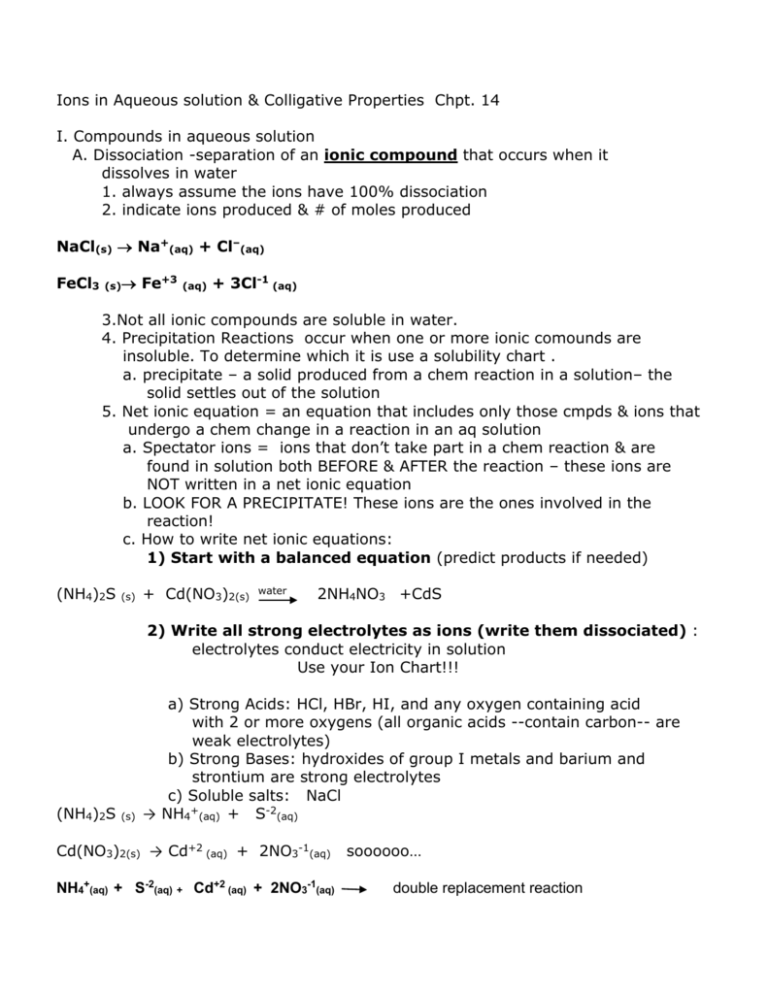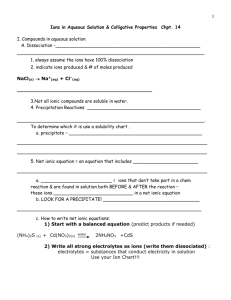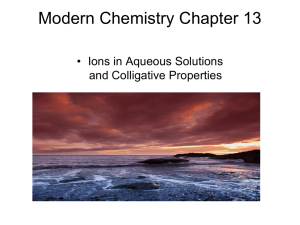Student Notes In Aqueous Solutions
advertisement

Ions in Aqueous solution & Colligative Properties Chpt. 14 I. Compounds in aqueous solution A. Dissociation -separation of an ionic compound that occurs when it dissolves in water 1. always assume the ions have 100% dissociation 2. indicate ions produced & # of moles produced NaCl(s) Na+(aq) + Cl–(aq) FeCl3 (s) Fe+3 (aq) + 3Cl-1 (aq) 3.Not all ionic compounds are soluble in water. 4. Precipitation Reactions occur when one or more ionic comounds are insoluble. To determine which it is use a solubility chart . a. precipitate – a solid produced from a chem reaction in a solution– the solid settles out of the solution 5. Net ionic equation = an equation that includes only those cmpds & ions that undergo a chem change in a reaction in an aq solution a. Spectator ions = ions that don’t take part in a chem reaction & are found in solution both BEFORE & AFTER the reaction – these ions are NOT written in a net ionic equation b. LOOK FOR A PRECIPITATE! These ions are the ones involved in the reaction! c. How to write net ionic equations: 1) Start with a balanced equation (predict products if needed) (NH4)2S (s) + Cd(NO3)2(s) water 2NH4NO3 +CdS 2) Write all strong electrolytes as ions (write them dissociated) : electrolytes conduct electricity in solution Use your Ion Chart!!! (NH4)2S (s) a) Strong Acids: HCl, HBr, HI, and any oxygen containing acid with 2 or more oxygens (all organic acids --contain carbon-- are weak electrolytes) b) Strong Bases: hydroxides of group I metals and barium and strontium are strong electrolytes c) Soluble salts: NaCl → NH4+(aq) + S-2(aq) Cd(NO3)2(s) → Cd+2 (aq) + 2NO3-1(aq) NH4+(aq) + S-2(aq) + Cd+2 (aq) + 2NO3-1(aq) soooooo… double replacement reaction Hints: Oxides, gases,and water are always written as molecular or undissociated 3) Check your solubility chart to see which new cmpd is insoluble. NH4+(aq) + S-2(aq) + Cd+2 (aq) + 2NO3-1(aq) NH4NO3(aq) + CdS (s) 4) Cross out all spectator ions (ions that are the same on the reactant and product side of the equation –if they stay dissolved then they are considered the same so, look for a precipitate…. something insoluble in water!) NH4+(aq) + S-2(aq) + Cd+2 (aq) + 2NO3-1(aq) NH4+(aq) + NO3-1(aq) + CdS (s) 5) Write the Net Ionic equation using the substance NOT crossed out! Cd+2 (aq) + S-2(aq) CdS (s) B. Ionization - breaking apart of some polar molecular compounds into aqueous ions (it’s the creation of ions where none previously existed!) 1. acids are polar molecules that ionize in water HNO3(aq) + H2O(l) H3O+(aq) + NO3–(aq) (H3O+ is the hydronium ion we’ll talk about it with acids) C. Molecular Solvation the molecules dissolve in water but they stay intact C6H12O6(s) C6H12O6(aq) these substances are nonelectrolytes! II. Colligative Property- property that depends on the concentration of solute particles, not their identity---- Changes in the behavior of the solutions that are due primarily to the concentration of solute particles rather than the typical properties of those substances are known as colligative properties. A. Types 1. Freezing Point Depression (tf) a. f.p. of a solution is lower than f.p. of the pure solvent t: kf: m: change in temperature (°C) constant based on the solvent (°C·kg/mol) page p.445 in the book molality (m) n: # of (ion) particles in solution (1 for non-electrolytes & you must write net ionic equations to find # for electrolytes) 2. Boiling Point Elevation (tb) a. b.p. of a solution is higher than b.p. of the pure solvent t: kb: m: n: change in temperature (°C) constant based on the solvent (°C·kg/mol) page p.445 in the book molality (m) # of (ion) particles in solution (1 for non-electrolytes & you must write net ionic equations to find # for electrolytes) 3. Osmotic pressure – external pressure that must be applied to STOP osmosis a. osmosis – movement of water through a semipermeable membrane from the side of lower [SOLUTE] to the side of higher [SOLUTE] OR the diffusion of water through a semipermeable membrane b. eventually the concentrations of the 2 solutions become equal (equilibrium) c. increasing the number of dissolved particles increases the osmotic pressure d. Osmotic Pressure of the Blood 1) Cell membranes are semipermeable 2) The osmotic pressure of blood cells cannot change or damage occurs. 3) The flow of water between a red blood cell and its surrounding environment must be equal (isotonic solution) a) Medically 5% glucose and 0.9% NaCl are used (their solute concentrations provide an osmotic pressure equal to that of red blood cells) b) Hypotonic Solutions Lower osmotic pressure than red blood cells Lower concentration of particles outside than inside RBCs In a hypotonic solution, water flows in to the RBC The RBC undergoes hemolysis; it swells and may burst. *Greater concentration of water outside cell than inside so water moves into the cell. c) Hypertonic Solutions Has higher osmotic pressure than RBC Has a higher particle concentration In hypertonic solutions, water flows out of the RBC The RBC shrinks in size (plasmolysis) *Greater concentration of H2O inside cell than outside so water moves out B. Applications 1. salting icy roads – lowers the f.p. of water so it must be colder outside in order to form ice 2. making ice cream-lowers the f.p. of ice & causes it to melt – when something melts it is an endothermic process!! It pulls E (heat) from the milk mixture making it colder 3. antifreeze – lowers f.p. of water & increases b.p. of water in radiator (-64°C to 136°C) 4. Dialysis a. Occurs when solvent (water) and small solute particles pass through a semipermeable membrane in kidney b. Large particles retained inside blood small stuff moves through to kidney & then to bladder c. Hemodialysis is used medically (artificial kidney) to remove waste particles such as urea from blood when kidney no longer functions C. Calculations 1.Find the freezing point of a saturated solution of NaCl containing 28 g NaCl in 100. mL water. NaCl Na+ + Clt: ? kf: 1.86 (°C·kg/mol) m: 4.8 m 28g convert to moles = .48mol then… .48mol/.100kg = 4.8 m n: 2 ions t = kf x n x m Δt = 1.86(°C·kg) x 2 x 4.8mol = 17.856 °C you’re not finished yet!! mol kg normal f.p. of water is 0°C so 0°C – 17.856 = -17.856°C









